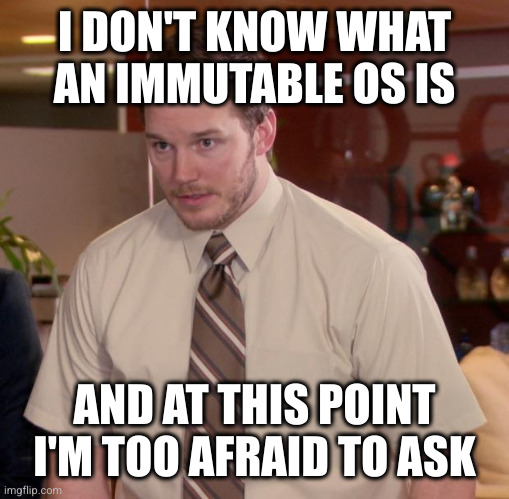this post was submitted on 24 Jul 2024
515 points (97.8% liked)
linuxmemes
24616 readers
766 users here now
Hint: :q!
Sister communities:
Community rules (click to expand)
1. Follow the site-wide rules
- Instance-wide TOS: https://legal.lemmy.world/tos/
- Lemmy code of conduct: https://join-lemmy.org/docs/code_of_conduct.html
2. Be civil
- Understand the difference between a joke and an insult.
- Do not harrass or attack users for any reason. This includes using blanket terms, like "every user of thing".
- Don't get baited into back-and-forth insults. We are not animals.
- Leave remarks of "peasantry" to the PCMR community. If you dislike an OS/service/application, attack the thing you dislike, not the individuals who use it. Some people may not have a choice.
- Bigotry will not be tolerated.
3. Post Linux-related content
- Including Unix and BSD.
- Non-Linux content is acceptable as long as it makes a reference to Linux. For example, the poorly made mockery of
sudoin Windows. - No porn, no politics, no trolling or ragebaiting.
4. No recent reposts
- Everybody uses Arch btw, can't quit Vim, <loves/tolerates/hates> systemd, and wants to interject for a moment. You can stop now.
5. 🇬🇧 Language/язык/Sprache
- This is primarily an English-speaking community. 🇬🇧🇦🇺🇺🇸
- Comments written in other languages are allowed.
- The substance of a post should be comprehensible for people who only speak English.
- Titles and post bodies written in other languages will be allowed, but only as long as the above rule is observed.
6. (NEW!) Regarding public figures
We all have our opinions, and certain public figures can be divisive. Keep in mind that this is a community for memes and light-hearted fun, not for airing grievances or leveling accusations. - Keep discussions polite and free of disparagement.
- We are never in possession of all of the facts. Defamatory comments will not be tolerated.
- Discussions that get too heated will be locked and offending comments removed.
Please report posts and comments that break these rules!
Important: never execute code or follow advice that you don't understand or can't verify, especially here. The word of the day is credibility. This is a meme community -- even the most helpful comments might just be shitposts that can damage your system. Be aware, be smart, don't remove France.
founded 2 years ago
MODERATORS
you are viewing a single comment's thread
view the rest of the comments
view the rest of the comments

If the immutability in OS is well designed, then there shouldn't be really an downsides or loss in comfort. That is, unless you're a linux expert and like to tinker under the hood.
The general idea is, the core of the OS if read-only, and everything else that needs to be modified is mounted writeable. Ideally, protecting the core of the OS from writes, should for example prevent malware from installing a modified kernel or boot loader. Or maybe preventing the user from accidentally borking something so that their system becomes unbootable. How much of an advantage that is practice is dependent on use case. In the case of Steam OS on the steam deck, it's perfect, since boot issues on the steam deck could potentially be tricky to fix as opposed to a standard PC.
Another advantage of immutable could theoretically be wear and tear of certain storage devices. e.g. Think of a raspberry PI and SDcards. If you could have most of the important stuff of the OS as read only on the SD card, and everything else on a usb disk or even an NFS mount, then the SD card should last much longer since no writes are happening on it.
As far as true security benefit is concerned... I can't really say. It depends on how updates and eventual writes are actually handled to the immutable part of the OS. Obviously at some point, changes do happen. Like during a system update. In the case of Steam OS, The system portion is wiped and replaced the new version. Chimera OS, did something similar (I don't know if they still use the same method). They had a read-only BTRFS partition, where they would then provide a new snapshot during an update, which would be downloaded and applied at the next reboot. This approach would hinder automated crypto malware for example (at least for system files).
Thank you, then it looks like I'll be giving the atomic one a try! I can always overwrite and install normal Fedora KDE if the atomic version is giving me issues after all :)